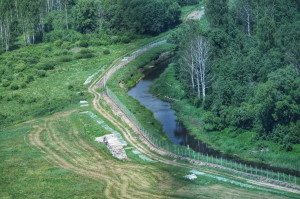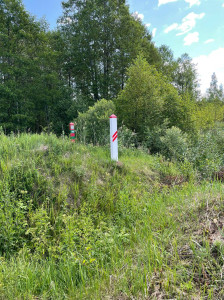







.png)
Improving the security of national borders by providing situation-appropriate conditions for effecting border security is considered a measure that protects the interests of national security by preventing a potential threat to the state: namely, an uncontrolled increase in the flow of migrants at the national border between the Republic of Latvia and the Russian Federation.
Appropriate infrastructure must be constructed in order to ensure that the border security function is performed effectively, according to the Law on Construction of the External Land Border Infrastructure and its summary.
The project for the construction of national land border infrastructure includes the construction of a high-security fence, patrol trails, planked patrol footpaths, etc.
Overall, the project envisages construction in a 283.6 km long border zone between the Republic of Latvia and the Russian Federation, taking into account the infrastructure already built. The construction will take place in multiple stages. The first stage covers the construction of a fence in the 57 km priority section. The section is particularly difficult, with some marshy areas and no previously built border infrastructure of any kind.
In the dry areas, the first stage will only include the construction of a fence, while in the marshes, the fence structure will include concrete pontoons making it possible to patrol these parts of the border. The second stage will include constructing a fence in the remaining sections, as well as other infrastructure in the sections that previously did not have it.
The commissioning of previously built infrastructure will take place at the same time. Completing the commissioning requires significant changes in the construction design, splitting it into stages, and providing design supervision for the process.
To solve the issue of safe movement of animals, a study will take place in September 2023 to produce a map of animal movement trails and a solution for crossings by animals. The study will be carried out by LVMZI Silava. This is a critical prerequisite for the preparation and approval of the construction plan documentation.
In order to get the most accurate information about the existing situation in the border zone and the infrastructure already built there, an on-site audit of the actual situation will take place in September 2023, providing the basis for future infrastructure construction solutions.
A fence is a physical barrier that makes it difficult to cross the border illegally and gives border guards time to detect a breach. The fence itself, the ability to move quickly, the patrol routes: all these elements help protect the border, offering good improvement in safety. Lithuania’s experience shows that a fence combined modern technical solutions is very effective.
Guntis Pujāts,
Head of the State Border Guard









-thumbnail.jpg)


